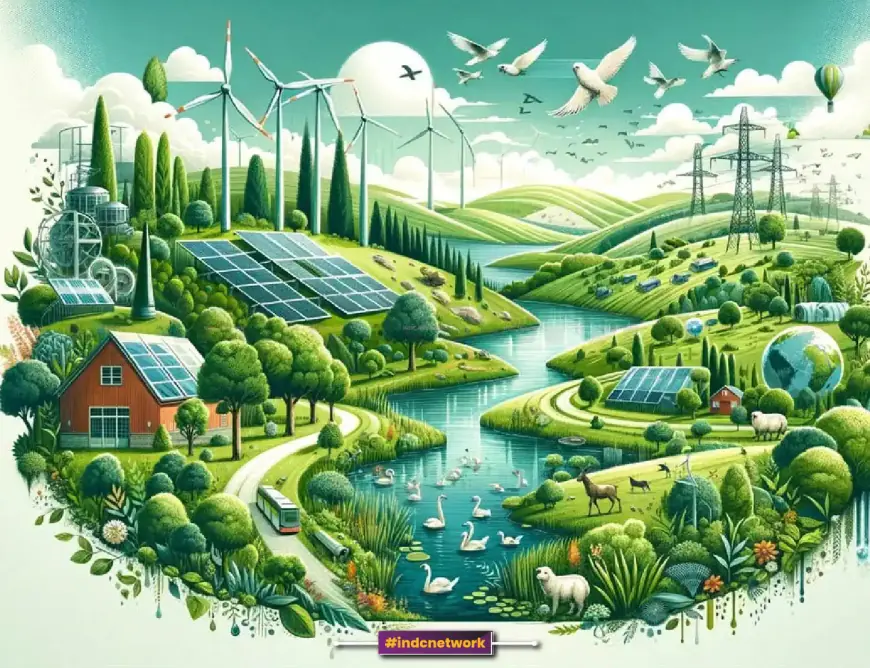How Environmental and Social Enterprises are Revolutionizing Sustainability and Changing the Future of Business
Environmental and social enterprises are playing a crucial role in the shift toward a sustainable future. By merging profit-making with purpose, these businesses address critical environmental and social challenges, creating a positive impact on both the planet and society. This article explores how environmental and social enterprises are reshaping industries, contributing to sustainable development, and driving social change.

INDC Network : Biography : Introduction: The Rise of Environmental & Social Enterprises
In the face of mounting global challenges—such as climate change, inequality, and social unrest—businesses are increasingly seeking ways to contribute to positive change. Environmental and social enterprises are at the forefront of this shift, blending the pursuit of profits with a strong commitment to environmental protection and social justice.
Environmental and social enterprises are businesses that prioritize both profit and purpose, addressing critical issues related to the environment, human rights, education, healthcare, and more. These enterprises focus on creating solutions that not only generate financial returns but also contribute to sustainable development, social equity, and economic empowerment.
The growth of this sector has been remarkable in recent years, with many businesses pivoting to sustainable models and committing to measurable impact. In this article, we will explore what environmental and social enterprises are, the role they play in society, and the ways in which they are shaping a more sustainable future.
What Are Environmental and Social Enterprises?
At their core, environmental enterprises aim to address environmental challenges such as pollution, deforestation, and biodiversity loss. These businesses focus on sustainable solutions that reduce ecological footprints, promote renewable energy, and create circular economies. Social enterprises, on the other hand, target social issues like poverty, access to education, healthcare, and gender equality. They focus on empowering marginalized communities, providing opportunities for economic development, and promoting social justice.
The defining feature of these businesses is their commitment to using business models that not only generate profit but also create positive societal and environmental impact. Impact investing, corporate social responsibility (CSR), and social entrepreneurship have all risen to prominence as part of this movement. These approaches ensure that enterprises contribute to both financial sustainability and positive social change.
The Key Drivers of Environmental & Social Enterprises
Several factors have driven the rise of environmental and social enterprises. Among the most significant are:
Increasing Consumer Awareness and Demand for Sustainability : Consumers are becoming more conscious of the environmental and social consequences of their purchases. There is a growing demand for products and services that are ethically sourced, environmentally friendly, and support fair labor practices. Millennials and Gen Z, in particular, are prioritizing brands that align with their values, pushing businesses to reconsider their impact on society and the planet.
Regulatory Pressure and Government Initiatives : Governments around the world are introducing stricter regulations on carbon emissions, waste management, and supply chain transparency. International agreements like the Paris Agreement on climate change and the UN Sustainable Development Goals (SDGs) have also set clear targets for businesses to follow. This regulatory landscape is encouraging companies to adopt sustainable practices to remain competitive and avoid penalties.
Access to Impact Investment and Funding : In recent years, there has been a boom in impact investing—investing in companies, organizations, and funds that generate positive social or environmental impact alongside financial returns. This influx of capital has enabled many environmental and social enterprises to scale and innovate. Impact investors include both private investors and large institutions, such as venture capital firms, foundations, and even governments.
Technological Advancements : Technological innovations are providing new opportunities for environmental and social enterprises to scale their impact. For example, renewable energy technologies are making clean energy more accessible, while digital platforms are helping social enterprises expand their reach, connect with communities, and access resources.
Consumer Expectations and Brand Loyalty : As businesses become more socially and environmentally responsible, customers increasingly expect companies to demonstrate their commitment to these values. Research shows that consumers are more likely to remain loyal to brands that show they care about environmental sustainability and social equity. Businesses that integrate these principles into their operations gain a competitive advantage, foster brand loyalty, and attract a growing customer base.
Examples of Leading Environmental and Social Enterprises
There are numerous examples of enterprises that have successfully integrated environmental and social goals into their business models.
Patagonia (Environmental Enterprise) : Patagonia, the outdoor apparel company, is often considered a model for environmental enterprises. The company has been a pioneer in sustainable sourcing, using recycled materials in its clothing and promoting fair labor practices. Patagonia is also committed to environmental activism, donating a portion of its profits to environmental causes and launching initiatives like Worn Wear, which encourages consumers to buy used or repaired items instead of new ones.
Patagonia's efforts have paid off: the brand has a strong customer base that values its commitment to the environment. Patagonia's business model shows that environmental sustainability can coexist with profitability, making it an inspiring example for other companies to follow.
TOMS Shoes (Social Enterprise) : TOMS Shoes became famous for its "One for One" initiative, which provided a pair of shoes to a child in need for every pair purchased. TOMS, founded by Blake Mycoskie in 2006, quickly became one of the most well-known social enterprises. While the company has since diversified its products and shifted its business model, the core principle of social responsibility remains. TOMS continues to invest in projects that address health, education, and economic empowerment in underserved communities.
Beyond Meat (Environmental Enterprise) : Beyond Meat, a company that produces plant-based protein products, is disrupting the food industry by offering sustainable alternatives to meat. By providing meat substitutes, Beyond Meat aims to reduce the environmental impact of traditional livestock farming, which is a significant contributor to greenhouse gas emissions, water waste, and deforestation. The company’s growth has been meteoric, with products now available globally in major supermarkets and restaurants.
Grameen Bank (Social Enterprise) : Founded by Muhammad Yunus, Grameen Bank is one of the most successful and impactful social enterprises in the world. It focuses on providing microloans to the poor and underserved communities, particularly women in rural areas. Grameen Bank’s model has helped lift millions of people out of poverty by providing access to capital that they would otherwise not have.
The Challenges of Environmental and Social Enterprises
While environmental and social enterprises are making an enormous impact, they face several challenges that can hinder their growth:
-
Balancing Profit with Purpose
While many enterprises want to achieve both financial and social/environmental objectives, striking the right balance can be difficult. Prioritizing sustainability can often result in higher operational costs, which may affect the bottom line, especially in the early stages of business. -
Access to Capital
Though impact investing has grown in popularity, securing funding for social enterprises can still be difficult. Traditional investors may not always recognize the value of social impact, focusing instead on financial returns. -
Scaling and Market Reach
While small social and environmental enterprises can make a significant impact locally, scaling up to reach broader markets presents unique challenges, such as maintaining quality, brand integrity, and the core mission while expanding. -
Supply Chain Sustainability
Managing a sustainable supply chain, from sourcing raw materials to ensuring ethical labor practices, is one of the biggest challenges for environmental and social enterprises. Transparency, traceability, and maintaining ethical standards throughout the supply chain are vital.
The Future of Environmental and Social Enterprises
The future of environmental and social enterprises looks promising, as consumers continue to demand sustainable products and services. The rise of impact investing, coupled with growing environmental and social awareness, is paving the way for more businesses to embrace purpose-driven models. Furthermore, technological innovations are providing solutions to previously insurmountable problems, allowing enterprises to scale their impact.
Environmental and social enterprises have the potential to be the driving force behind a more equitable and sustainable global economy. As the world faces the dual crises of climate change and social inequality, these businesses will play a critical role in shaping the future.
What's Your Reaction?













































































































































































